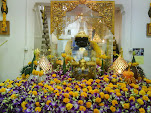 The art of U Thong originated in the Central region of Thailand between the 12th and 15th Centuries A.D. The style was developed was influences from different areas. U Thong Art falls into 3 distinct types.
The art of U Thong originated in the Central region of Thailand between the 12th and 15th Centuries A.D. The style was developed was influences from different areas. U Thong Art falls into 3 distinct types.- Type 1 : This first and rarely encountered type presents a mixture of Dvaravati and Khmer influences. Distinguishable features are the lotus bud aureole, the hair frame, a Khmer styled square face and the long robe with the edge cut in a straight line. The base tended to be plain with an inward set V shaped hollow.
- Type 2: Bearing a stronger resemblance to Khmer and Lopuri style art, Buddha images of the second type typically feature fine hair curls and a hair band. Occasionally the hair was tied into a topknot or transformed into a cone shaped cranial protuberance. A rather stern expression shown on a square face was similar to that of Lopuri style and the chin had a human like cleft. The mantle, smaller than the Lopuri style was sut into a straight edge. The Buddha is usually created in the Subduing Mara Posture. The lap is narrow and the shins are ridged ( called the "sharp shinned" design). The base is con-cave with no decoration.
- Type 3: Although strongly influenced by art from Sukhothai, some U Thong characteristics were retained as seen in the hair band & the base with the inverted V shaped hollow. This style probably originated between the 14th and 15th centuries A.D
胡


No comments:
Post a Comment